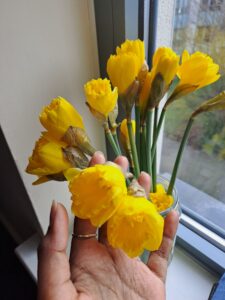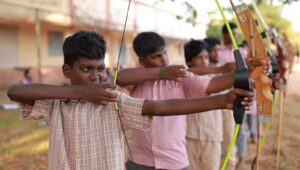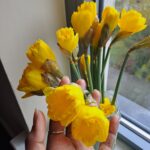
Vaccinating Tribals. Nilgiris Shows the Way. Stories of Courage and Grit.

Dr R Sandhya trekked for an hour in the forest to administer the second dose to 80 year old Bommi, a tribal woman.
As India celebrates administering a billion doses of vaccine against COVID, we take you on a trek to the tribal hamlets on the Nilgiris, for stories of courage, grit and determination by doctors and health workers who fully vaccinated the 21000 strong tribal population, winning over strong vaccine hesitancy.
After a twenty kilometre hill drive on a battered ghat road from her primary health centre, Dr R Sandhya and her team of a nurse and an Asha worker, all women trek for an hour inside a forest area on a series of difficult slippery hilly terrain to arrive at Sembakolli, a tribal settlement. Waiting for them is Bommi, a fragile eighty year old Kurumbar tribal woman for her second shot. After an examination by Dr Sandhya, her team administers the second dose to the grand ma and collect her details for online entry later.
Speaking to TellMyStory.in Bommi said “We don’t go to hospitals or medical camps. We accept this vaccination only because, doctors and nurses come to our place“.

Vaccine hesitancy: No virus can attack me, so much of venom in me says Bomman, a tribal man who ultimately took his shots.
There is worry of rains. The health workers team quickly negotiates a narrow steep lane and treks another half a kilometre to inoculate 65 year old Bomman, a tribal man living alone in a dilapidated hut which doesn’t have even a power connection. He lives alone after his wife passed away. “My body is strong, with lot of venom inside. No virus can hit me” he says after he was administered the second dose.
The team trekked for two hours to inoculate just four tribals. “Even if one tribal is left out, the virus could spread to nearly 500 tribals here. Many from these hamlets don’t come to our centres. So it’s very important we go looking for them” Dr Sandhya said on the significance of their hard work as dozens of medical teams reach out to nearly 1300 tribal settlements in Nilgiris.
Beyond the terrain and distance, there are other difficulties. As we trekked further crossing a stream, the village head nurse R Malarkodi carrying the vaccine was bitten by a leech. She screamed in pain. Pointing us towards the leech that was stuck to her ankle sucking blood, she said, “Despite all these, as a health worker I am proud of this mission to keep people safe amid the pandemic“.
This was the time, a hunt was on to nab a man-eater tiger in the forest area around 10 KM away but that did not scare Kali, an Asha worker to reach out to these households alone the day before to inform them so they would be home for the doses. “The fear of animals would always be in my mind” says Kali. Explaining the larger challenge se said “Tribals don’t have mobiles. There is poor connectivity anyway. So, I ought to go personally“.
Over the last few months doctors, nurses and health workers braved so many challenges and nightmare reaching out to around 1300 tribal settlements to ensure everyone is inoculated. “If it rains in the forest, often there wouldn’t be even any shelter for us enroute as these hamlets are spread out” explained Dr Elavenil, an Assistant Surgeon who led us.
Vaccine hesitancy among tribals was a major challenge as a large percentage of tribals do not come to primary health care centres or to special vaccination camps. The district administration managed to first win the confidence of a few tribals to get both shots and made them vaccine ambassadors. “When tribals see me healthy after vaccination they gain confidence when we ask them to get vaccinated. Otherwise, many belive they would die after inoculation” says Sridhar, a vaccine ambassador.
Talking about the mission, Mrs J Innocent Divya, Nilgiris Collector explained “The NGOs played an important role. We even scored a vaccine jingle in tribal languages“. On what worked she said “We had to make several visits even to a single village but that did not deter us. This has been the most satisfying experience for me in my career“.
Talking about their experience in this “Winning their confidence is the most challenging and difficult thing” said Dr K.B Elavenil. “We began with health education and brought about behavioral changes” he explains.
We returned to the car after nearly three hours of grueling trek. We joined another team led by Dr Arunmozhi Varman at Kottai Mattam, after a twenty-minute drive. A twenty minute further walk took us to a tribal settlement where around thirty men and women were waiting for their doses. This area also borders the forest area where a hunt was on for the killer tiger. Explaining the precautions the doctor adds “My family is a bit scared but I work here over the last four years and we are used to the terrain“. We of course “consult forest officials before every such visit” he adds.
Untold stories of hard work and grit to reach remote areas dot India’s billion doses story towards turning the country covid-free.
- Tags: covid vaccine, Nilgiris, tamilnadu, Tribals, Vaccine

Tell My Story
Related News


A Ministry of Presence

Every Sinner has a Future


Are You Overthinking the Negative What Ifs?

The Faces of Him



It’s Messy, But It’s Healing
Recent Stories

The Girl Who Stopped Adjusting

A Ministry of Presence

Every Sinner has a Future


